ATLANTA HISTORY
The first town was Omnia, 2 miles west and 2 miles south of the present Atlanta. It was thought the railroad was coming that direction. Then there were rumors the railroad was going 1½ miles south and 1 mile east. The town was moved and called Baltimore. The railroad finally came through where the present Atlanta is, so Baltimore was moved to what is now Atlanta. (For a time the new town was known as "Day".) The first depot agent was from Atlanta, Georgia and named the new town Atlanta.
The town site was surveyed in April 1885 and the first train ran between Beaumont and the state line on August 28, 1885.
Atlanta was built on land purchased from William H. Day located in the Southwest quarter of section 15 and the Southeast quarter of section 16 in Omnia Township. William H. Day was president of the town site company.
William Earnest Darlington, the son of George and Lettie (Gillard) Darlington drove the stake that established the town site. He was born in Illinois and was twelve years old at this date.
In 1900 the town was incorporated and Willis Wilson, who had homesteaded in Richland Township in 1870, was elected the first mayor.
Robert S. Strother, who homesteaded east of Atlanta, was the first Justice of the Peace.
Charles E. Grant was the first Constable.
The founding of the town of Atlanta in northeastern Cowley County resulted from the building of the Kansas City and Southern Railroad, which came through that section to the southwest. This branch of the railway afterwards became a part of the Frisco System in Kansas.
CHURCHES
The first church built in the town was the Methodist Episcopal-South. Many of the early settlers of this community came from southern states and southern traditions predominated. The Reverend Broadhurst was the first pastor of this church.
The next denomination to establish a church home was the Christian church. The first pastor was P. H. Guy.
In the course of time the Methodist Church-South was succeeded by the Methodist Church and a new building was dedicated November 11,1900. This was burned in 190?, and another church was dedicated.
All church buildings were built by the citizens, who contributed their time, money and labor that the community might have religious teaching and fellowship.
The cemetery was established in 1885, and Minnie Craig, daughter of Mr. and Mrs. P. W. Craig was the first burial there.
SCHOOLS
The first school was taught by May Kinley in 1885 in the upper room over her father’s drug store. It was supported by subscription. The drug store was destroyed by fire and the second term was taught in the old Methodist Episcopal Church South, and Anna Primrose was the instructor. A two-room schoolhouse was built in 1886, and a Miss Stanley (or Stanberg) was employed by the school board. The school building was the community center for all social and business gatherings.
A band was organized in the winter of 1885, and George M. Shelley was the director.
Dwellings
The first dwelling in the town was brought in on wheels by George W. Davis from the village of Polo, located southwest of Atlanta. The village is now extinct.
William Gillard and Willis Wilson both erected homes at about this same date. These dwellings were in the southwest part of the town, not far north of the railroad. They were built before the first train passed through the town.
Roster of businessmen in 1885
| Hardware | Willis Wilson |
| Groceries | E. D. Doty |
| General Merchandise | Gillard Darlington, E. M. Dunbar |
| Drugs | Mr. Kinley |
| Lumber | Snodgrass, Gross Dicus |
| Hotel | George B. Darlington, A. T. Borrough, Sam Cowley |
| Real Estate | Day Strother |
| Newspaper | P. W. Craig |
| Livery Stable | Chas. M. Grant, Chas. Work |
| Blacksmith | George W. Davis, J. C. Curry |
| Meat | Arkansaw Wilson |
| Barber Shop | Ed Haycraft |
| Shoe Shop | Bert Clawsey |
| Station Agent | A. H. Hickson |
| Painters | W. M. Elden and James Simpson |
| Carpenters | George Culbison, Williams Co., Haycraft Bros. Zeigler Brothers |
More business men in 1885
Professional Men Dr. Daniels; Dr. McGinnis; Dr. Archer' and Dr. D. Cunningham were the pioneer physicians of the town. The first three mentioned eventually moved to other localities.
Biographical
Dr. D. Cunningham, 1837-1901, was born in Indiana, migrated westward in 1851 living in Illinois, Missouri and Cherokee county Kansas, before locating in the northwest quarter of section 3 in Omnia Township in 1877. He began the practice of medicine in Illinois, which he continued after his location on his claim, having established an office in his residence on the farm where he lived and ministered to the ill of the community until 1900 when he moved to Atlanta and practiced until his death the following year.
He was a man of unique character and devoted to his profession. He was successful in agriculture pursuits and at the time of his death, owned a large tract of land located in Cowley and Butler counties. He also owned a number of town lots in Atlanta and built one of the most substantial businesses of the town on the northeast corner of the town square.
Politically he was a reformer and was an ardent supporter of the Populist Party in 1889-90, and was elected Coroner at that date. His wife was Nancy Kent whom he married in 1880. They were the grandparents of the celebrated Glen Cunningham (son of Mr. and Mrs. Clinton Cunningham) who has won world fame as the greatest middle distance runner of his day (1935). His greatest victory however was his grim determination to overcome apparently insurmountable physical handicaps to accomplish this distinction.
Willis Wilson, 1835-1920 was born in Indiana and served in the Civil war from that state. He came to Cowley County in a covered wagon and homesteaded on Dutch creek in 1870. The Indians were still roaming the plains, and it was four miles from his preemption to the nearest settler. In 1885 Mr. Wilson retired from farming and built one of the first store buildings in Atlanta and embarked in the hardware business, which he later sold and purchased the building that W. H. Day had built and engaged in general merchandising. This store he sold to Burns and Grissem in 1893 and engaged in business with his son Henry Wilson, selling hardware implements and vehicles. After retiring, he moved to Winfield. When the town of Atlanta was incorporated in 1900 Mr. Wilson was elected as the first mayor. He was active in the Methodist church and all civic affairs of his vicinity.
Robert S. Strother was born in 1840 in Kentucky, and served in the Civil war from that state. In February 1870 he was married to Miss Jennie Crawford and that fall migrated to Cowley County and homesteaded in Omnia Township East Of Atlanta. Mr. Strother was prominently identified with the early history of Atlanta, conducting a real estate office and acting as a peace officer. He was associated with J. S. Kidwell in conducting a general store. In 1891 he was elected Registered of Deeds and the family moved to Winfield.
J. S. Kidwelll homesteaded in Harvey Township and in 1883 sold his homestead to J. E. Griffin and he moved to Atlanta where the town founded and engaged in merchandising. He received the appointment of Postmaster under President Cleveland, succeeding George B. Darlington.
William H. Day was born in Kentucky in 1831. In 1869 he was married to Martha Montgomery in Chicago, Illinois. In 1869 he came to Cowley County and purchased land on which Atlanta was built which later he sold to the town site company. For a time the new town was known as "Day". Mr. Day built the first business of the town on the northwest corner of the public square. He engaged in the real estate business with Robert S. Strother and was an enthusiastic promoter of the various activities of the town. At that time his family lived in Augusta. They later moved to Winfield, and he engaged in the hardware business.
A. H. Hickaon was the first station agent in Atlanta. His successor was a Miss Burris. During the intervening years (fifty) but six incumbents have served in this capacity. John Jones became agent in 1899 and has served for thirty-six years.
P. W. Craig was the pioneer newspaperman of the town, owning and editing the Atlanta Advertiser in 1885. He later edited the Dexter Free Press.
Milo Copeland established the Atlanta Cricket in 1888.
O. Ferguson owned and edited the Atlanta Record in 1905.
A. L. Crow edited the Atlanta Journal at one time.
Byron Darlington and W. L. Reagan owned and edited the Journal from 1909 to 1914.
Charles W. Brannum also engaged in the publication of the Journal at a more recent date.
Gillard and Darlington were the earliest merchants of the town. They moved their stock of general merchandise from the trading post of Baltimore located two and one-half miles south east of the new town site. Their merchandise was freighted in by team and wagon until the railroad was completed. Baltimore was established in 1871, and is recorded as an important geographical point in the early history of Cowley County. It is now listed as one of the lost towns of the county.
William H. Gillard was born in Illinois and came to Cowley County in 1871 and located on section 27 in Omnia Township. This was before the organization of the township, which occurred February 6, 1873 and Mr. Gillard was elected as the first Trustee of the township. He was also appointed Postmaster at Baltimore in 1878 and conducted the office in connection with their store. Mr. Gillard built one of the first dwellings in Atlanta and was prominent in the early affairs of the town during the organization days. His wife was Miss Delana Jenkins, the daughter of Mr. and Mrs. William (Cap) Jenkins, early pioneers of Omnia Township.
George B. Darlington, 1845-1926, was born in Ohio, and the family migrated to Illinois. In 1873 Mr. Darlington, his wife and small son, William Earnest, came to Cowley County, and he homesteaded south of Atlanta. He was associated with his brother-in-law, William H. Gillard, in conducting a general store at Baltimore when it was the outstanding trading post of the northern part of the county. Mr. Darlington succeeded Mr. Gillard as postmaster at Baltimore and was the incumbent when Atlanta was established and served as post official in the new town until a political change in the presidential administration occurred.
Mr. Darlington erected a hotel in Atlanta soon after the town was started and was active in other enterprises besides merchandising. He was twice married. His first wife was Lettie Gillard--sister of W. H. Gillard-who died in 1885; he later married Miss Ella Williams who was a native of Nebraska and came to Atlanta the year it was founded.
Strother Field at Winfield, Kansas was named for Donald Strother who was killed in service in the beginning of World War II. He was the grandson of Robert S. Strother.

Atlanta Depot
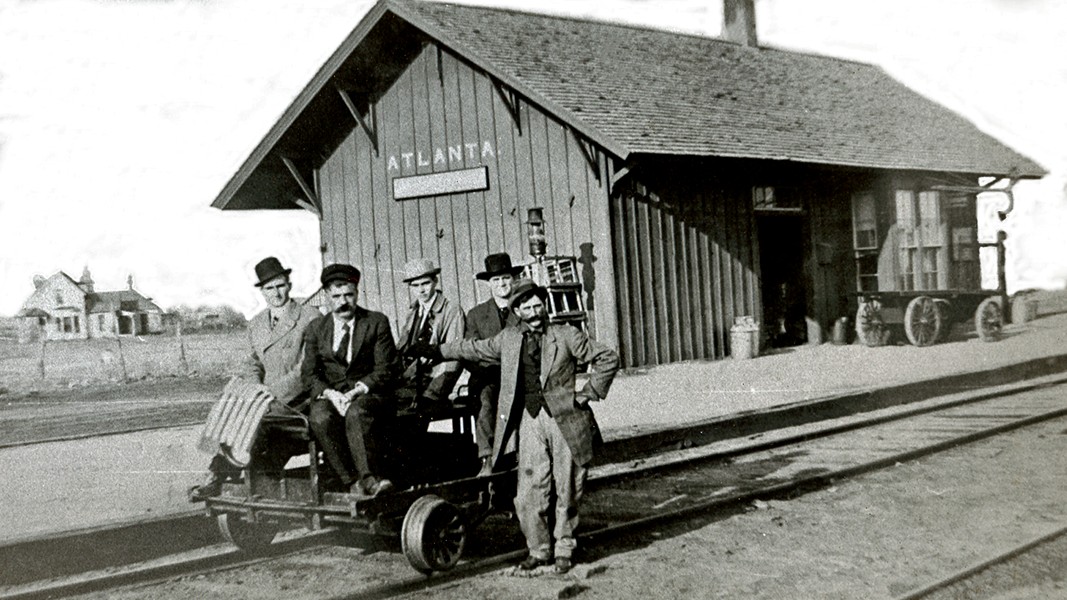
Atlanta Depot
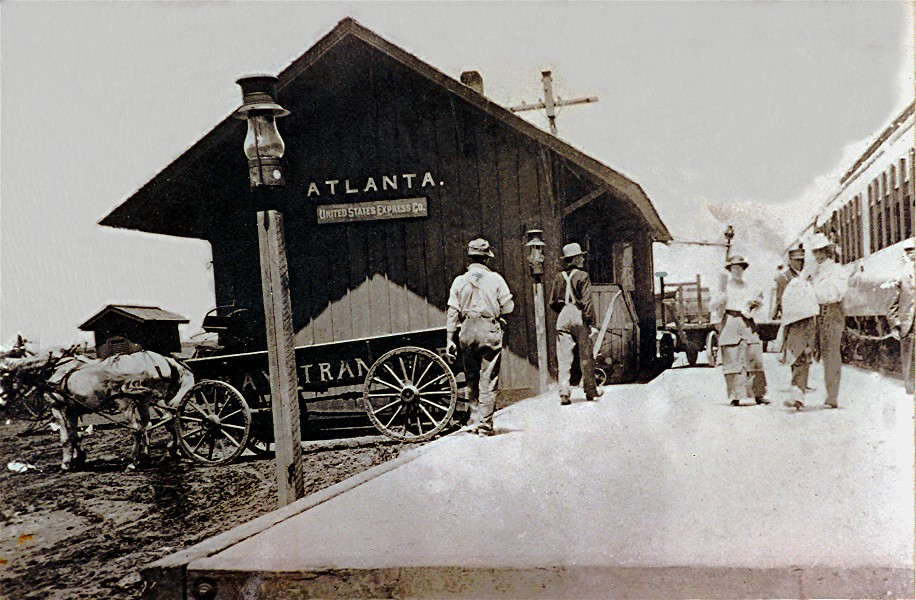
Atlanta Depot
Atlanta Post Office
The Atlanta Post Office was first opened August 14, 1885. Joseph F. Kidwell was the first postmaster. The building pictured is one of several locations occupied by the Post Office through the years.
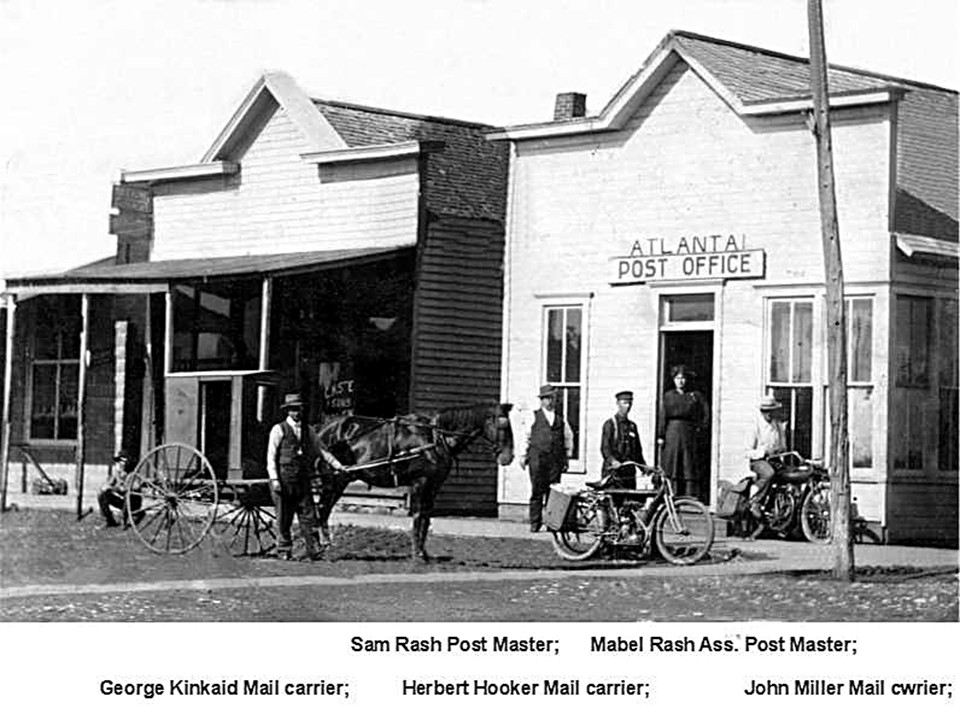
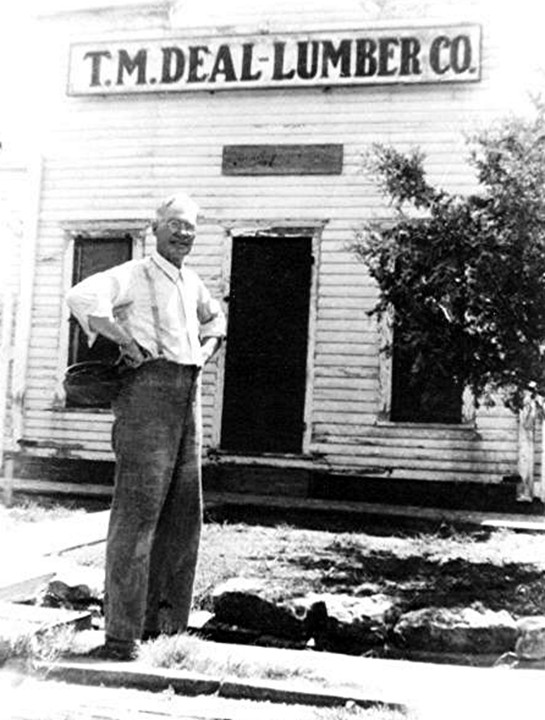
Otis T. Fabian 1933 Undertaker and Lumber
Atlanta, as I remember by Mabel Fabian Ensley
Methodist Church on Main Street burned.
H. R. Ina Weaver had a large dept. store it burned.
Jake Minnie Troutman (brother sister worked here later.)
Lewbook, Bakery.
Earnest (Cudhay) Martin Laura had a grocery meat market.
Orville Shaffer had a small cafe.
Bank, Bert Smith was president.
Dale Mary Bickham had a grocery store as well as a drug store.
The present post office was a large dept. grocery store owned by Minnie Roy Rogers. It was sold later to Charlie Florence Foust. The upstairs was a lodge (Odd Fellows Rebecca). There was the first telephone upstairs as well.
Jim Burdette had a Ford agency.
Ike Gregory, a barber shop.
Harvey Ketterman had a leather harness shop.
The old show building that is now the community building had cartoons and mostly Westerns melodrama. It was of course silent piano was used for variations. George Peterson, I believe, owned the building. Smith Snodgrass was in charge of the various shows, with Lawrence Ratts, I believe, running the different reels.
Around south of community building was my Dad's, Otis Fabian, business from 1922-1932. He was an undertaker. The hearse was in back room, caskets office were in front.
Later a cream station run by Ernest Darlington's mother. I don't remember her name, she was always called Grandma Darlington.
The Christian church was a white structure across the street. When Harvey Blair and others built the new church, George Peterson purchased the old one and moved it to northeast part of town. I think it was called Bible Church, but I'm not sure.
Roy Houser had a large filling station garage at one time. Dr. Dunbar Dr. Ira Smith shared an office. Later Dr. Dunbar left for Winfield. Then later Dr. Smith moved office to east of main square.
My grandfather, Charles G. Fabian, was born in Birdsong, Germany in 1855. The coat of arms of Fabian meant "Keeper of the gates". I understand this is what his folks did at one of the castles., One of granddad's sisters also worked there.
My Granddad came to America when he was 16 on a cattle boat with a visitors pass to New York to visit an aunt. Some Germans had been relocated in Prussia.
My Dad, Otis Fabian, never talked much about his folks but his brother, James (or Uncle Jim to us), but told of my older brother's much of what we know.
Charles G. Fabian Sarah Caroline Ridpath were married Sept. 24, 1877 in Iowa. They homesteaded, I presume some acreage, where Mike Crowley lives, near Mt. Vernon District (east of Atlanta).
Otis Thomas (O. T. as he was known in later years), was born in a dugout on March 7, 1879. Grandma or someone held him over a stove to keep from freezing. A house was built later on the property when his brother James was born.
My grandfather passed away at age 55. He had acquired 2 houses a home in Winfield on 6th St., where his last years were spent, leaving the 2 farms to Otis James. My Dad (Otis), looked at the one in Altus, Okla., decided on the one in Cowley County.
My grandparents are buried in Winfield. After my grandfather's death, one of my brothers, Bud, lived with my grandmother had some schooling in Winfield, Ks.
Otis, was a man of many talents. He married Nona Olive Pininger, June 3, 1900. He just had an 8th grade education but taught many years of school in various county schools. Mr. Vernon, Box, one near Maple City, I don't know the official name but it was known a Buzzard Roost. He taught several years before he was married. I had 2 brothers, Howard Marion (Bud) that he taught.
I was the youngest of 7 living children of which I graduated from Atlanta High School.
One year Otis had 55 pupils from 1-8 grades at the one school called Buzzard Roost. I think was when a student threw a knife at him but it was deflected by his suspenders. I understand the student was severely punished.
He farmed as well as taught. I don't know when they moved to Atlanta, the north part where I was born. He was a carpenter as well as building homes. He built the white house on the south edge of Atlanta moved in when I was 5 years old. Thelma Lanier told me that he had built one for her Dad, Herbert Groom. Several others around the Doyle farm house north west of Atlanta. My father took me on my first airplane ride 80 years ago. (about 1923)
He was also a funeral director or undertaker, as they were called. There was a building next to the community building, the back room he parked the hearse, and the office coffins were in the front. As he didn't have a license to embalm he would get Mr. Gann from Burden or one from El Dorado. They didn't always embalm in those days but buried the bodies within 2-3 days. Many times there was a casket with a body in our living room. Many were kept at their homes. Dad also made some baby caskets. Susie Houser lined the inside and whey were nice. He was in business from 1922-1932.
He was also a substitute mail carrier for awhile. My Mom and Dad were members of Christian Church where Dad was Sunday School Supt. part time. He had a good tenor voice and he also carried services as a lay men to some of the county churches.
During the Depression we lost the house lived in various places in Atlanta. He was a member of Odd Fellows Lodge as well as a Mason, school board member. In fact, he signed my graduation diploma.
He was manager of T. M. Deal Lumber Co. for the last years of his life. He was still working at the time of death Feb. 3, 1946, at age 67.
Ollie Martin had a shoe store on corner, there was a restaurant on east of Ollie Martin Dr. Smith's office. Farther east was a hotel. The only 2 that I remember running it was Mrs. Osborn Mrs. Randall.
On Main we had another filling station garage owned by Claude Jenkins.
A large hardware store was on north George Chenoweth, later housed another grocery store.
Curley Likens had a Chevrolet agency.
Ernie and Luva Foote had a produce station on Main Street.
Later a house was built west of Main St. the telephone exchange was located Mrs. Bean lived there as well.
There was once a newspaper, a livery stable. I don't remember that.
The old depot east of Main use to be a gathering place for young people. We spent a lot of evenings playing games such.
The post office was in two different locations before the present location.
The city bldg. was once a jail, later a library.
Atlanta my Dad were very closely related as he lived his entire life around in Atlanta.
CouchPOAtl.jpg)
Patricia (Tish) Couch, Retired Atlanta Postmaster
By Lynette Dyson
Traveler regional editor
ATLANTA - The third time was a charm for Atlanta back in 1885.
Thanks to unsuccessful tries at establishing other communities nearby, Atlanta came to be.
Tish Couch. Unofficial town historian, said the first town, Omnia, was started about two miles southwest of Atlanta, People flocked there because they thought the Kansas City and Southern Railroad would go through there.
But, when they found they were wrong - that officials planned a different route for the tracks - they moved to a new site, called Baltimore, about one and a half miles south and one mile east of present day Atlanta.
Again, the company didn't plan to route the train through the new town of Baltimore, so, for the third time, residents moved again, this time to Atlanta, and finally got it right, Couch said.
Because the train was the reason for the town's existence, it seemed fitting that the community be named for the hometown of the first depot agent -- Atlanta, Ga.
The branch of railway through Atlanta later became a part of the Frisco System in Kansas.
The townsite was surveyed in April 1885 and the first train ran between Beaumont and the state line on Aug. 22, 1885, before the ties were laid to complete the track.
William H. Day bought the land and became president of the townsite company. William E. Darlington, the son of George and Lettie (Gillard) Darlington, drove the stake that established the townsite. He was born in Illinois and was 12 years old at the time.
Robert S. Strother, who homesteaded east of town, was the first judge and Charles M Grant was the first constable.
Atlanta was incorporated in 1900 and Willis Wilson, who had homesteaded in Richland Township in 1870, was the first mayor.
The first church built in Atlanta was the Methodist Episcopal-South, because many of the settlers came from southern states and had southern traditions.
The Christian Church was the next church established. Soon after that. the Methodist Episcopal Church-South became the Methodist Church and a new building was dedicated in November 1900.
The cemetery was established in 1885. Minnie Craig was the first person buried there.
The first school was taught by May Kinley in 1885 in the room above her father's drug store. The store was destroyed by fire and the second term was taught in the old Methodist Episcopal Church-South, where Anna Primrose taught. A two room schoolhouse was built in 1886.
The first dwelling in town was brought in on wheels by George W. Davis from the village of Polo, which was southwest of Atlanta at the time.
In 1885, the town had stores offering hardware, groceries, general merchandise, drugs, lumber, real estate, meat and shoes. There were also three hotels, a newspaper, two livery stables, two blacksmith shops, a barber shop two painters. Four physicians and four carpenters.
Couch was born in 1923, when the town was at its peak. The oil boom of 1917-20 brought many people to town. Couch remembers a theater with silent movies, a Texaco plant southwest of town and a restaurant Garages to service both Fords and Chevrolets were located where the firehouse is today, she said. There were also harness and millinery shops at that time.
Walking down main street now, one has a hard time imagining that the city had all of those services at one time. Couch said the businesses that had survived up until the 1960s suffered a final blow when the Atlanta High School closed in 1966.
There are but a few businesses left on main street - more empty buildings are seen than anything -- but the memories remain.
ATLANTA CHRISTIAN CHURCH
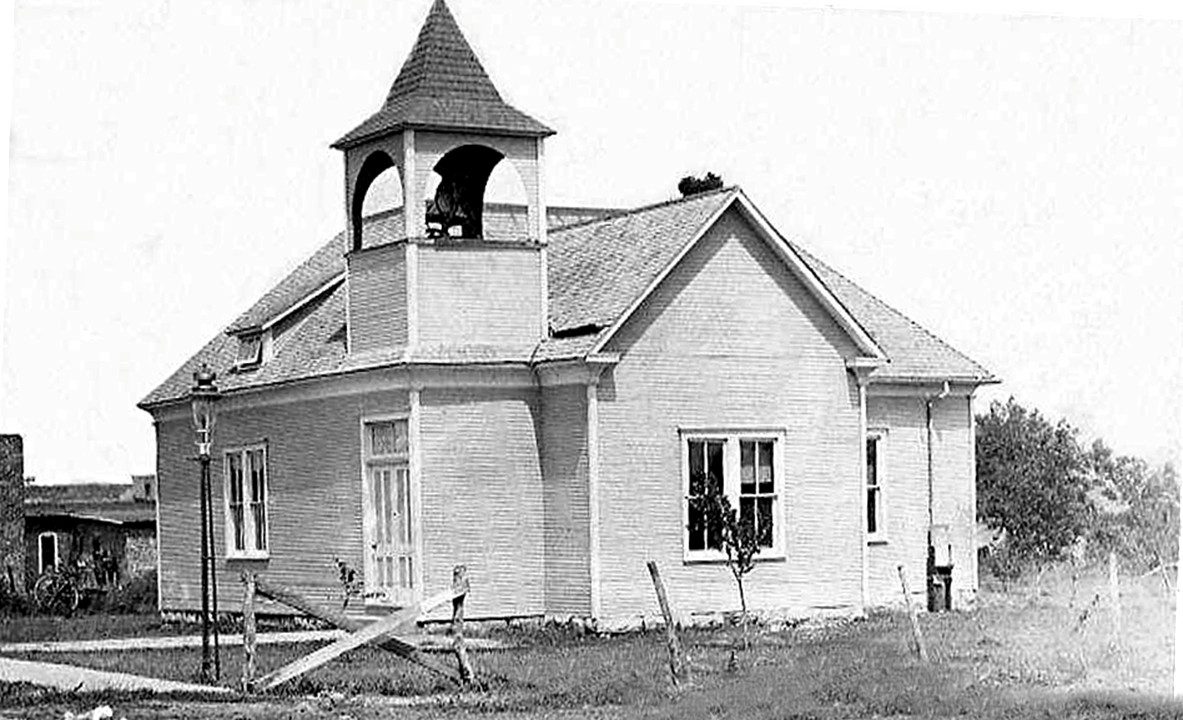
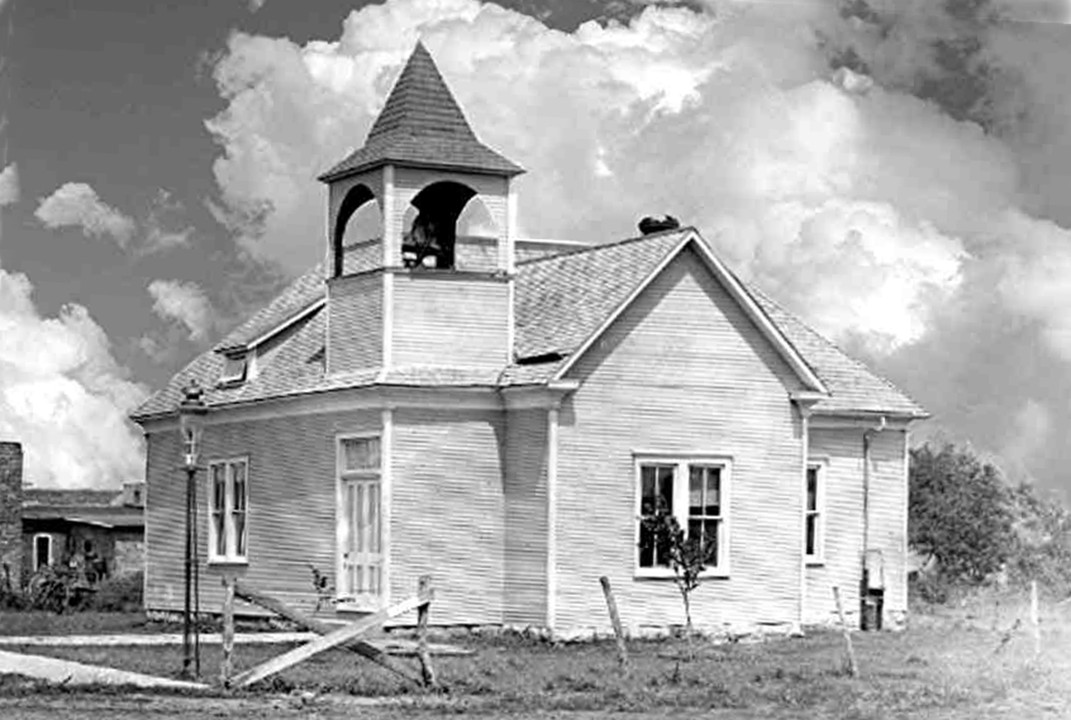
E-Mail from (Rev) Gary Rolph, Oct 3 2004
Jean and I appreciated our ministry at Atlanta Christian Church. After only one semester at Phillips Seminary, we moved full time to Atlanta, Kansas, and lived in the parsonage until we left for the 1st Christian Church of Marysville (Kansas), then Canada, Brazil, back to Canada, and now New Hampshire! Our oldest son, Matthew Rolph, was born (30 Nov 1970) in Winfield Hospital and spent much of the first year of his life in the parsonage at Atlanta. We remember the heavy snow storm in December 1970 when the town was buried with snow for a few days. We made it to within a block of the parsonage (after having had Sunday supper with members of the Atlanta Church who lived in town) then walked the rest of the way home with Matthew swaddled in blankets.
All the members of the Atlanta Christian Church, as well as the fine families in the United Methodist and Friends' Churches, helped Jean and me get started in ministry. We appreciated the Christian dedication of so many members and friends of Atlanta Christian Church. We also still thank all those in the community that got together and raised enough money so that we could pay the hospital bill for our first child's birth. That was a Christmas present we still remember with great gratitude.
We have lost contact with most members of the Atlanta Christian Community. We used to correspond with Helen Willard but have not heard from her in a few years. But I still remember the many who helped give me a real down-to-earth understanding of ministry.
Thank you all.
(Rev) Gary Rolph, MCS, BCC
Chief of Chaplains
VA Medical Center
Manchester NH 03104
Isaac Stanley Gregory Barber Shop
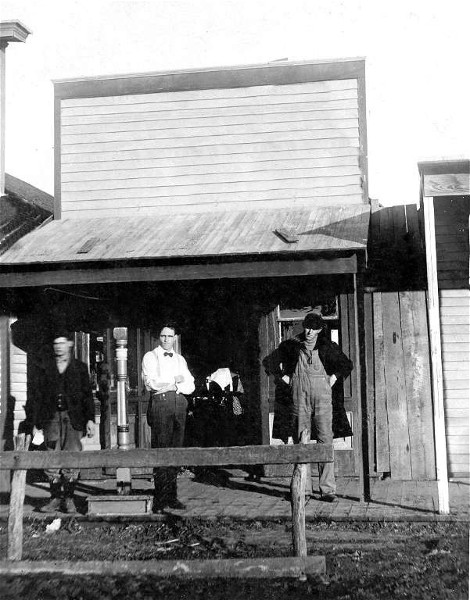
The man in the middle is Issac Stanley Gregory.
